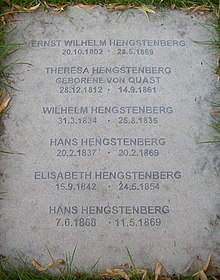Ernst Wilhelm Hengstenberg

Cet article est une ébauche concernant le protestantisme.
Vous pouvez partager vos connaissances en l’améliorant (comment ?) selon les recommandations des projets correspondants.

| Naissance | |
|---|---|
| Décès | (à 66 ans) Berlin  |
| Nom dans la langue maternelle | Ernst Wilhelm Theodor Hengstenberg  |
| Nationalité |  Province de Westphalie (Saint-Empire romain germanique/Royaume de Prusse) Province de Westphalie (Saint-Empire romain germanique/Royaume de Prusse) |
| Formation | |
| Activités | Théologien, professeur d'université, écrivain  |
| Père | Johann Heinrich Karl Hengstenberg (d)  |
| Fratrie | Karl Hengstenberg (d) Ida Hengstenberg (d) Eduard Hengstenberg (d)  |
| A travaillé pour | |
|---|---|
| Maître | Johann Jakob Stähelin (en)  |
modifier - modifier le code - modifier Wikidata
Ernst Wilhelm Theodor Herrmann Hengstenberg ( - ), est un théologien protestant allemand représentatif du néo-luthéranisme.
Biographie
Issu de la famille Hengstenberg (de), en 1853-1854, il fit paraître dans la Evangelische Kirchenzeitung une série d'articles antimaçonniques qui aboutiront en 1854 en un livre attaquant la franc-maçonnerie[1].
Thèses
Il attribue au travail des loges maçonniques le déclin et même la disparition de la foi chrétienne chez les adeptes de la réforme protestante[2].
Publications


La traduction de cet article ou de cette section doit être revue ().
Le contenu est difficilement compréhensible vu les erreurs de traduction, qui sont peut-être dues à l'utilisation d'un logiciel de traduction automatique. Discutez des points à améliorer en page de discussion ou modifiez l'article.
- Christologie des Alten Testaments (1829–1835; 2nd ed., 1854–1857; Eng. trans. by R Keith, 1835–1839, also in Clark's Foreign Theological Library, by T Meyer and J Martin, 1854–1858), a work of much learning the estimate of which varies according to the hermeneutical principle of the individual critic
- English translation in (Google Books)
- Beiträge zur Einleitung in das Alte Testament (1831–1839); Eng. trans., Dissertations on the Genuineness of Daniel, and the Integrity of Zechariah (Edin., 1848), and Dissertation on the Genuineness of the Pentateuch (Edin., 1847), in which the traditional view on each question is strongly upheld, and much capital is made of the absence of harmony among the negative
- English translation in (Google Books for Vol. 1) (Google Books for Vol. 2)
- English translation in (Google Books)
- Die Bücher Moses und Aegypten (1841)
- English translation in (Google Books)
- Die Geschichte Bileams u. seiner Weissagungen (1842; translated along with the Dissertations on Daniel and Zechariah)
- Commentar über die Psalmen (1842–1847; 2nd ed., 1849–1852; Eng. trans. by P Fairbain and J Thomson, Edin., 1844–1848), which shares the merit and defects of the Christologie
- English translation in (Google Books for Vol. 1) (Google Books for Vol. 2) (Google Books for Vol. 3)
- Die Offenbarung Johannis erläutert (1849–1851; 2nd ed., 1861–1862; Eng. trans. by P. Fairbairn also in Clark's " Foreign Theological Library," 1851-1852)
- English translation in (Google Books for Vol. 1) (Google Books for Vol. 2)
- Das Hohe Lied ausgelegt (1853)
- Der Prediger Salomo ausgelegt (1859)
- English translation in (Google Books)
- Das Evangelium Johannis erläutert (1861–1863; 2nd ed., 1867-1871 Eng. trans., 1865)
- Die Weissagungen das Propheten Ezechiel erläutert (1867–1868).
- English translation in (Google Books)
Of minor importance are:
- De rebus Tyrioruz commentatio academica (1832)
- Uber den Tag des Herrn (1852)
- Da Passe, ein Vortrag (1853)
- Die Opfer der heiligen Schrift (1859)
Several series of papers also, as, for example:
- "The Retentio of the Apocrypha,"
- "Freemasonry" (1854)
- "Duelling" (1856)
- "The Relation between the Jews and the Christian Church" (1857; 2nd ed., 1859), which originally appeared in the Kirchenzeitung, were afterwards printed in a separate form.
Posthumously published:
- Geschichte des Reiches Gottes unter dem Alten Bunde (1869–1871)
- Das Buch Hiob erläutert (1870–1875)
- Vorlesungen über die Leidensgeschichte
Voir aussi
Liens externes
Sur les autres projets Wikimedia :
- Ernst Wilhelm Hengstenberg, sur Wikimedia Commons
- Notices dans des dictionnaires ou encyclopédies généralistes
 :
: - Britannica
- Brockhaus
- Deutsche Biographie
- Store norske leksikon
- Treccani
- Notices d'autorité
 :
: - VIAF
- ISNI
- BnF (données)
- IdRef
- LCCN
- GND
- Italie
- Pays-Bas
- Israël
- NUKAT
- Suède
- Vatican
- Norvège
- Tchéquie
- Grèce
- Corée du Sud
- WorldCat

- Hengstenberg and His Influence on German Protestantism The Methodist Review 1862, vol. XLIV, p. 108
- Johannes Bachmann (de): Ernst Wilhelm Hengstenberg. Drei Bände. Bertelsmann, Gütersloh 1876/1880/1892 Band 1, Band 2, Band 3
- Martin Gerhardt (fortgeführt von Alfred Adam): Friedrich von Bodelschwingh. Ein Lebensbild aus der deutschen Kirchengeschichte. 1. Bd. 1950, 2. Bd. 1. Hälfte 1952, 2. Hälfte 1958.
- Joachim Mehlhausen (de): Artikel Hengstenberg, Ernst Wilhelm. In: TRE 15, S. 39–42.
- (de) Karl Kupisch (de), « Hengstenberg, Wilhelm », dans Neue Deutsche Biographie (NDB), vol. 8, Berlin, Duncker & Humblot, , p. 522–523 (original numérisé).
- Hans Wulfmeyer: Ernst Wilhelm Hengstenberg als Konfessionalist (de). Erlangen 1970.
- Friedrich Wilhelm Bautz, « Hengstenberg, Ernst Wilhelm », dans Biographisch-Bibliographisches Kirchenlexikon (BBKL), vol. 2, Hamm, (ISBN 3-88309-032-8, lire en ligne), col. 713–714
- Helge Dvorak: Biographisches Lexikon der Deutschen Burschenschaft. Band I: Politiker, Teilband 2: F–H. Heidelberg 1999, S. 297.
Notes et références
- ↑ The politics of sociability: freemasonry and German civil society, 1840-1918, par Stefan-Ludwig Hoffmann, p.80
- ↑ Jean Guillaume Gyr, La Franc-Maçonnerie en Elle-même et dans ses Rapports avec les autres Sociétés Secrètes de l'Europe, notamment avec la Carbonarie Italienne, Liège, Imprimerie de J.-G. Lardinois - Paris, Librairie de P. Lethielleux, 1859, p.V
 Portail du protestantisme
Portail du protestantisme  Portail du XIXe siècle
Portail du XIXe siècle  Portail du royaume de Prusse
Portail du royaume de Prusse












